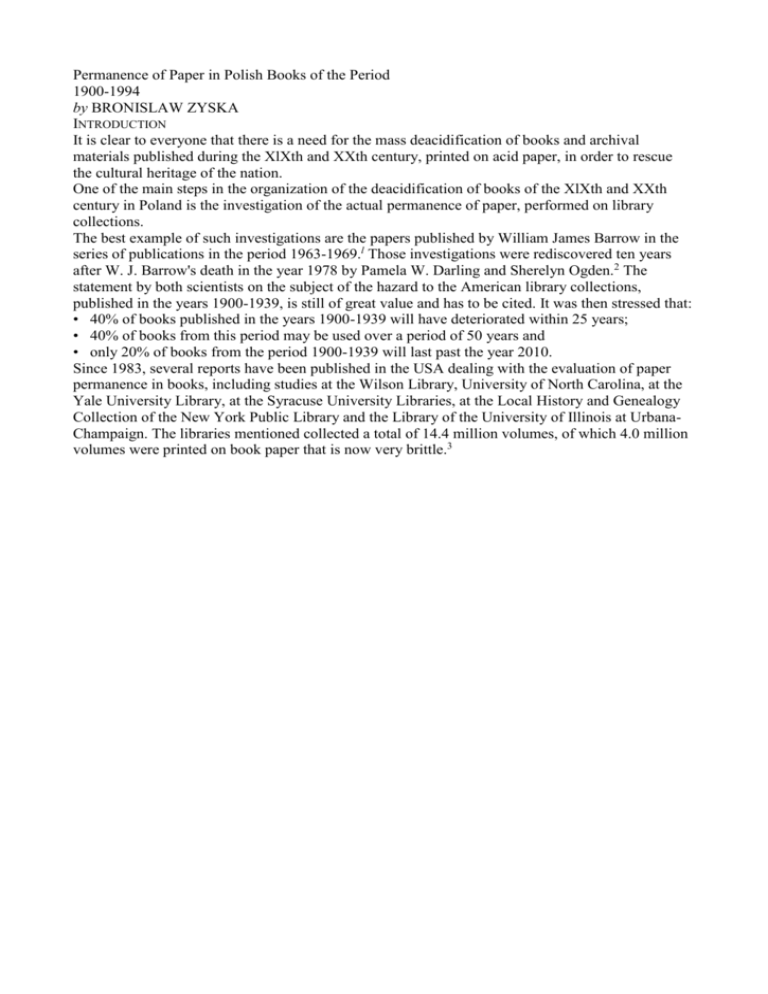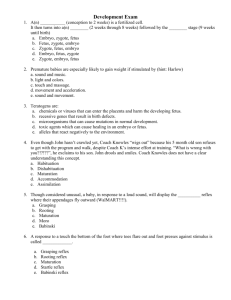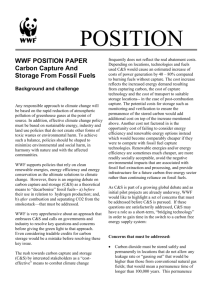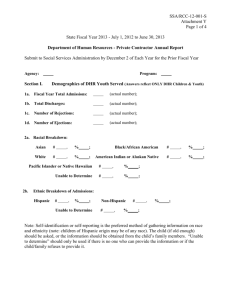Permanence of Paper in Polish Books of the Period
advertisement

Permanence of Paper in Polish Books of the Period 1900-1994 by BRONISLAW ZYSKA INTRODUCTION It is clear to everyone that there is a need for the mass deacidification of books and archival materials published during the XlXth and XXth century, printed on acid paper, in order to rescue the cultural heritage of the nation. One of the main steps in the organization of the deacidification of books of the XlXth and XXth century in Poland is the investigation of the actual permanence of paper, performed on library collections. The best example of such investigations are the papers published by William James Barrow in the series of publications in the period 1963-1969.l Those investigations were rediscovered ten years after W. J. Barrow's death in the year 1978 by Pamela W. Darling and Sherelyn Ogden.2 The statement by both scientists on the subject of the hazard to the American library collections, published in the years 1900-1939, is still of great value and has to be cited. It was then stressed that: • 40% of books published in the years 1900-1939 will have deteriorated within 25 years; • 40% of books from this period may be used over a period of 50 years and • only 20% of books from the period 1900-1939 will last past the year 2010. Since 1983, several reports have been published in the USA dealing with the evaluation of paper permanence in books, including studies at the Wilson Library, University of North Carolina, at the Yale University Library, at the Syracuse University Libraries, at the Local History and Genealogy Collection of the New York Public Library and the Library of the University of Illinois at UrbanaChampaign. The libraries mentioned collected a total of 14.4 million volumes, of which 4.0 million volumes were printed on book paper that is now very brittle.3 Similar investigations were undertaken in West Germany in 1988 on behalf of the Deutsches Bibliotheksinstitut, in 54 scientific libraries, which collected 82.6 million volumes altogether. A sample of 7110 volumes was taken from those libraries in which, among other parameters, the paper performance was tested. U. Usemann-Keller4 reported that 12% of the volumes had been printed on good paper that was now very brittle and broke after 3 double folds, done manually. On the basis of the investigation it was concluded that of 152 million volumes in German scientific libraries, 18 million cannot be rescued even by mass deacidification because of the brittleness of the pages. The paper performance in books and archival materials was also investigated in West Germany in 1992 by Peter Zeisler, Udo Hamm and Lothar Gottsching.5 The research activity on the evaluation of paper permanence in library collections performed in the USA and West Germany is of the greatest value in the estimation of hazard to libraries due to acid paper. Similar investigations have been undertaken at the Institute of Library Sciences, Silesian University, in Katowice. Preliminary results have been published since 1988 and have dealt with the following fragments of book collections: • 64 volumes of XlXth century Silesian prints;6 preliminary results of the folding endurance in 303 volumes of Polish books from the period 1810 1980;7 • pH and folding endurance in 121 Polish volumes from the period 1960—1979, as well as their classification according to the five groups of permanence of William James Barrow;8 • pH and folding endurance in 43 Polish prints of the period 1861—1870;9 • pH and folding endurance in 111 books and pamphlets printed in Cieszyn, dating from the period 1818-1910, as well as their classification according to William James Barrow;10 • the permanence of printing paper in 49 volumes of the Polish biographical dictionary from the period 1977—1992, including their classification according to William James Barrow;11 • the permanence of printing paper in 142 books and pamphlets printed in Cieszyn, dating from the period 1860-1939, as well as their classification according to William James Barrow;12 • the permanence of printing paper in 1026 volumes of Polish books, dating from the periods 1810-1909, 1920-1939 and 1950-1994, as well as their classification according to William James Barrow.13 This article presents the evaluation of book paper performance in 1395 volumes of Polish books dating from the period 1900-1994. To evaluate the process of book paper deterioration, estimation of the pH and folding endurance were selected as test properties. The significance of the folding test was categorized according to the method conceived by William James Barrow in 1959. In the statistical analysis of results the single linkage method was used according to the formula of Lance-Williams.18 22 MATERIAL AND METHODS A total of 1395 Polish books from the period 1900-1994 were chosen for testing. Table 1 presents the data for books investigated. They were divided into consecutive decades, starting from 19001909. In the decades 1900-1909, 1910-1919 and 1940-1949 the number of investigated books is very low, because it was difficult to collect a larger amount of copies from those periods. The decade 1940-1949 is represented only by books printed in the period after World War II, i.e. from the period 1946-1949. The publishing of Polish books during World War II was absolutely forbidden by the Nazis. Differences in the number of books tested for folding endurance and pH results from the fact that sometimes the three parameters could not be tested simultaneously, i.e. folding endurance in machine direction and cross direction, and pH. Folding endurance Folding endurance tests were performed on Schopper apparatus according to the Polish standard PN-73/P-50134.14 The size of the samples was 10X1.5 cm, cut Table 1. Polish books investigated for the permanence of printing paper, dating from the period 1900-1994 from the margins of paper, parallel with and perpendicular to the line of printing. Up to 10 samples were tested for each direction, i.e. the machine and cross direction. In the series of 10 results, the fifth result was chosen as median. The standard tension of 1 kG was used in the estimation of folding endurance. The moisture of book paper at testing was 8-10%. pH measurements pH was measured by a cold extraction method according to BS 4971: Part 1: December 197315 and Polish standard PN-84/P-5010916, using pH meter type OP-205/1 Radelkis (Hungary) with Radelkis Universal Electrode. The weight of paper samples was 1 ±0.01 g. Classification of book paper permanence In our investigations, to categorize the durability of books from the period 1900— 1994, we used the classification of William James Barrow, published in 1959 in his book "Deterioration of Book Stock. Causes and Remedies".17 The details are given in Table 2. Statistical analysis of results by clustering of data or cluster analysis can be used for multivariate analyses. A classical example is when an investigator groups the cases according to features. Details are given by J. E. Mezzich and H. Solomon18, J. E. Overall and C. J. Klett19, S. G. Johnson20, P. R. Kreishnaiah and L. N. Kanal21 and R. G. Brereton.22 In the statistical analysis of results the single linkage method was used according to the formula of Lance-Williams. The first group of features are the average and median of double folds of paper samples in machine direction, average and median of double folds in cross direction and the pH of paper, in all, five features. The objects from 1 to 10 represent the decades: 1900-1909, 1910-1919, 1920Table 2. Classification of the permanence of books according to William James Barrow 1929, 1930-1939, 1940-1949, 1950-1959, 1960-1969, 1970-1979, 1980-1989 and the five year period 1990-1994. As the second group of features, four in all, data connected with the pH of paper were chosen: minimum pH, average pH, median pH and maximum pH. Book papers with a pH over 5.9 have been excluded from that analysis. There were 27 samples out of the total of 1363 in the whole period 1900-1994. RESULTS Folding endurance Table 3 presents the results of folding endurance in the machine direction as well as in the cross direction, given as the median of number of double folds for each decade between 1900 and 1994. For each direction and each decade the medians are presented as the minimum, middle and maximum median of number of double folds. The most important figures in Table 3 are the middle medians. As can be seen, in the period 1900-1959 the middle median of double folds varies in the machine direction between two and three folds and in the cross direction between one and two folds. A slight increase can be observed in double folds in both directions for the period 1960-1979. A remarkable and justified increase of the middle median for the period 1980-1994 can also be observed. Table 3. Number of double folds of the paper in Polish books dating from the period 1900-1994 Table 4. pH of paper in Polish books dating from the period 1900-1994 pH of paper Table 4 presents the results of the pH of paper measured by a cold extraction method given as medians for each decade of the period 1900-1994. The medians are presented as the minimum, middle and maximum median of paper in books tested. The variation of the middle median of pH of paper is very low in the period 1900-1969. During the period 1970-1994 a small increase of pH over the value of pH 5.0 was observed. Of the total number of 1363 volumes tested, only in 27 volumes was the pH higher than 5.9. Those measurements will be discussed in future investigations. Classification of book paper permanence Table 5 presents the results of the book paper permanence according to the classification of William James Barrow. As can be seen for the period 1900-1979, in consecutive decades 93-100% of volumes were made of paper categorized as of the first and second class of permanence. In the first class of permanence, from 25% of volumes from the decade 1970-1979 to 83% of volumes from the decade 1900-1909 have been classified. In the decade 1980-1989 and in the years 1990-1994, changes in the classification are evident, as the percentage of books in the first class of permanence amounts here to 7% in the period 1980-1989 and only 1% in the years 1990-1994. Table 5. Classification of the permanence of book paper in Polish books in the period 1900-1994 Cluster analysis of results Table 6 gives the raw data for the cluster analysis for 10 objects and five features. Table 7 comprises the Euclidean distances for nine clusters, basing on the data from Table 6. The Euclidean distances of succeeding clusters are presented in Fig. 1. As can be noted, the closer this distance is to zero, the more similar the Table 6. Raw data for cluster analysis of double folds and pH of book paper in the period 1900— 1994 Table 7. Clusters calculated by the single linkage method based on data from Table 6 objects are. Let us present the calculations of the Euclidean distances on the basis of analyzed features of book paper (double folds and pH) in decades as objects. The most similar objects are the paper of books made in the decades 1900- 1909 and 1910-1919. Close to book paper quality from the period 1900-1919 is Fig. 1. Cluster analysis of double folds and pH of book paper in the period 1900-1994. that of book paper from the decade 1920-1929. The next (cluster 3) is the book paper of the decades 1940-1949 and 1950-1959. Cluster 4 represents the book paper of the period 1900—1929 and the decade 1930-1939. Cluster 5 encloses the features of book paper of the period 1900-1939 and the two decades 19401959, having, as cluster 4 does, the Euclidean distance of 0.010905. Cluster 6 encloses the features of book paper from the decades 1900-1959 and the decade 19601969; while cluster 7 is very similar to cluster 6, when the features of book paper of the decades 1900-1969 are included the decade 1970-1979. The book paper from decade 1980-1989 (object 9) and the 5-year period 1990-1994 (object 10) differ greatly in the levels of double folds. For such reasons, cluster 8 includes data of the period 1900-1979, the decade 1980-1989 has the value of the period 1900-1979, the decade 1980-1989 has the value of the Euclidean distance of 0.067106, while cluster 9 includes data of the period 1900-1989 and the 5-year period 1990-1994, having a very high Euclidean distance, 0.332208. Looking at Tables 5 and 6 one may note that in the decades between 1900 and 1979 the permanence of book paper was very low and it decreased even further in the next decades. Because of low pH, the forecast for the permanence of the book paper of the period 1980-1994 is also rather negative. Table 8. Raw data for cluster analysis of pH of book paper in the period 1900-1994a a Values of pH 6.0 or higher have been excluded. Because of the importance of the influence of book paper pH on its permanence, the cluster analysis of the pH of book paper over the whole period 1900— 1994 was done. The raw data for such an analysis have been given in Table 8. Values of the pH of book paper of 6.0 or higher have been excluded from this table. Books with this higher book paper pH will be separately investigated in the future. As mentioned before, 27 books were included in this cluster. Table 9 presents the Euclidean distances for nine clusters, calculated on the basis of four features (Table 8) for 10 objects, i.e. nine decades of the period 1900-1989 and the 5-year period 1990—1994. The Euclidean distances of consecutive clusters are shown in Fig. 2. Table 9. Clusters calculated by the single linkage method based on data from Table 7 Fig. 2. Cluster analysis of pH of book paper in the period 1900-1994. Let us present the calculations of the Euclidean distances on the basis of analyzed features of the book paper, i.e. minimum, average, median and maximum pH, in the period 1900-1994, divided into 10 objects. The most similar objects, from the point of view of the pH of book paper, are represented by the decades 1920-1929 and 1950-1959. This statement is very important as it proves the similarity of book paper pH in two different historical periods, i.e. for books printed before World War II and books printed after it. Close to the book paper of the above two decades in terms of permanence, is the book paper of the decades 1960-1969 and 1980-1989, grouped as cluster 2. The same applies to cluster 3, which includes the book paper of the decade 1930-1939. In cluster 4 we have the book paper of the decades 1900-1909 and 1910-1919. The similarities in the acidity of book paper may be noted as far as cluster 9. The values of the Euclidean distances are in all the decades, i.e. objects, very low, demonstrating that the differences in pH are very small throughout the whole period 1900-1994. This is the evidence of the very poor permanence of book paper used in publishing in the period 1970— 1979 and of the decrease in the strength of book paper during the period 19801994. CONCLUSION This study is devoted to the estimation of the permanence of paper in 1395 Polish books of the period 1900-1994. The following features were selected for the evaluation of the permanence of paper: the folding endurance tested on Schopper apparatus and the pH measurements by a cold extraction method. The durability of the paper was categorized according to the classification of William James Barrow. For multivariate analysis of the measured features over the period 19001994, divided into decades, the method of cluster analysis was chosen, with the aim of applying the single linkage method, according to the Lance-Williams formula. In the period 1900-1959 the middle median of double folds varies for the machine direction, between two and three folds, and for the cross direction between one and two folds. In the decades 1960-1969 and 1970-1979 a small increase in double folds in both directions could be observed. The data for double folds on paper in books printed in the period 1980-1994 obviously cannot be considered. The middle median of the pH of paper varies in the period 1900-1969 between 4.60 and 4.99. In the decades 1970-1979 and 1980-1989 the middle median pH of paper is of the 5.06-5.10 level, and for the period 1990-1994 it amounts to 5.25. For the period 1900-1979, in consecutive decades, from 93 to 100% of volumes were made of paper the permanence of which is categorized as first or second class according to W. J. Barrow's classification. Cluster analysis may be used in the investigation of the book paper permanence as a very interesting method of evaluation of the properties of paper, but always in comparison with the consecutive decades of the period 1900-1994. ACKNOWLED GEMENTS I am grateful to my students Iwona Balska, Malgorzata Berndt, Sylwia Blasz-czyk, Katarzyna Boron, Anita Drabik, Hanna Jaeger, Sylwia Kornke, Beata Kozakiewicz, Aleksander Lech, Ilona Luszniak, Krystyna Labanowicz, Karin Sularczyk, Piotr Szatoh, Barbara Szymon, Beata Wolak and Bogumila Ziołko for valued technical assistance in estimating the folding endurance of book papers, to Dr. Andrzej Misiolek for estimation of the pH of book papers and to Benedykt Bularz for the calculations in the cluster analysis of results. I wish to thank my friend Dozent Dr. Adam W. Jarosz for assistance in the investigations and in the discussions of the results. I am grateful to the Jagiellon- ian Library in Krakow, to the Library of Central Mining Institute in Katowice and to the Regional Public Library in Katowice for providing books for the tests on paper permanence. SUMMARIES Permanence of Paper in Polish Books of the Period 1900-1994 The study is devoted to the estimation of the permanence of paper in 1395 Polish books of the period 1900-1994. As features for the evaluation of the permanence of paper, the folding endurance and the pH measurements by a cold extraction method have been chosen. Categorization of the durability of the paper was undertaken according to the classification of William James Barrow 1904-1967. For multivariate analysis of the measured features over the period 1900-1994, divided into decades, the method of cluster analysis was chosen, applying the single linkage method, according to the Lance-Williams formula. For the period 1900-1979 in consecutive decades, from 93 to 100% of volumes were made of paper the permanence of which is categorized as first or second class, according to W. J. Barrow's classification. Permanence du papier de livres polonais datant de la periode 1990-1994 Cette etude a pour objet revaluation de la permanence du papier de 1395 livres polonais datant de la periode 1900-994. Les tests choisis pour evaluer la permanence du papier sont la resistance au pli et la mesure du pH apres extraction a froid. On a etabli des categories de durability du papier selon la classification de William James Barrow 1904-1967. Pour l'analyse multivariee des mesures effectuees pour la periode 1900-1994, par periode de dix ans, on a choisi la methode des clusters appliquant la methode de correspondance simple selon la formule Lance-Williams. Pour la periode 1900-1979, en decennies consecutives, de 93 a 100% des volumes sont composes de papier dont la permanence est consideree comme premiere ou deuxieme classe selon la classification de W. J. Barrow. Die Alterungsbeständigkeit der Papiers in Polnischen Büchem aus der Zeit 1900 bis 1994 Die Studie gilt der Abschätzung der Alterungsbeständigkeit des Papiers in polnischen Büchern aus der Zeit 1900 bis 1994. Als Abschätzungskriterien wurden Falzzahl und pH (Kaltextrakt) gewählt. Die Papiere wurden entsprechend der Klassifizierung von W. J. Barrow in funf Qualitätsstufen einge-teilt. Als Multivarianz-Analyse der gemessenen Eigenschaften wurde, in Einteilung nach Dekaden 1900-1994, die Cluster-Analyse mit Einfachverknupfung nach der Lance-WilliamsFormel gewählt. 93-100% der zwischen 1900 und 1979 hergestellten Bücher gehoren in die unterste oder die zweitunterste Klasse der Barrow'schen Einteilung. REFERENCES 1. Barrow, W. J.: Permanence/ durability of the book. I. A two-year research program. Richmond, Virginia, 1963. //. Test data of naturally aged papers. Richmond, Virginia, 1964. ///. Spray deacidification. Richmond, Virginia, 1964. IV. Polyvinyl acetate (PVA) adhesives for use in library bookbinding. Richmond, Virginia, 1965. V. Strength and other characteristics of book papers, 1980-1899. Richmond, Virginia, 1967. VI. Spot testing for permanence/durability of book papers. Richmond, Virginia, 1969. 2. Darling, P. W. & Ogden, S.: From problems perceived to programs in practice: the preservation of library resources in USA, 1956-1980. Library resources and technical services 25 (1981): 9-29. 3. Zyska, B.: [On the permanence of book papers.] Katowice: Instytut Biblioteknoznawstwa, 1993: 1— 148 (English, German and Russian Summaries). 4. Usemann-Keller, U.: Bestandschaden in deutschen Bibliotheken. Untersuchung von 0,01% der Bestande aus-gewahlter Bibliotheken der Bundesrepubltk durch das Deutsche Bibliothekinstitut. Zeitschrift fur Bibliotheksw-esen und Bibliographic, Frankfurt/M (1989): 109-23. 5. Zeisler, P., Hamm, U. & Gottsching, L.: Untersuchungen zum Zustand von Papier in Archiven und Bibliotheken. In: Plasmann, E., Muller, H., Tussing, W, eds. Frankfurt am Main: 81. Deutscher Bibliothekartag in Kassel 1991. 1992: 55-74. 6. Zyska, B. & Pietraszek, E.: [Permanence of nineteenth-century book papers in Silesia.] Roczniki Biblio-teczne, R. XXXII (1988): 293-306. (Russian and French summaries). 7. Zyska, B. J. &Jarosz, A. W: The awareness of conservation. Ten years of experience at the Silesian University, Katowice, Poland. Restaurator 13 (1992): 138-47. 8. Zyska, B.: [Permanence of the book paper of Polish booh of the period 1960-1979. Bulletin No. 2.] In: Zmigrodzki, Z., ed. Studie bibliologiczne 6 (1993): 140-6 (Russian and English Summaries). 9. Zyska, B. & Mrowiec, E.: [The evaluation of the permanence of paper in the Polish prints from 1861-1870. Bulletin No. 3.] In: Zyska, B., ed. Studia bibliologiczne 7 (1993): 123-30 (Russian and English Summaries). 10. Zyska, B. & Mrowiec, E.: [Assessment of the permanence of paper in printed works from Cieszyn of the period 1818-1910. Bulletin No. 4.] In: Zyska, B., ed. Studia bibliologiczne 8 (1994): 145-61 (Russian and English Summaries). 11. Zyska, B. & Lech, A.: [Assessment of the permanence of print paper in the Polish Biographical Dictionary from the period 1977-1992. Bulletin No. 5.] In: Zyska, B., ed. Studia Bibliologiczne 8 (1994): 162 71. (Russian and English Summaries). 12. Zyska, B.: [Assessment of the permanence of Cieszyn prints from the period 1860-1939 and prospects of their saving.] In: Panic, I., ed. Z problemow ochrony, konserwacji i rejestracji regionalnego dziedzictwa pismiennic-zego. Panic, I., ed. Cieszyn: Ksiaznica Cieszynska, 1994: 7— 26. 13. Zyska, B.: [Acid paper. The hazard for XlXth and XXth century prints.] Katowice: Wojewodzka Biblio-teka Publiczna, 1995: 1-44. (English Summary). 14. Polish Standard PN-73/P-50134. [Products of the paper industry. Estimation of folding endurance.] 15. BS 4971: Part 1: December 1973. A recommendation for repair and allied processes for the conservation of documents. Appendix B. Method 1. 16. Polish Standard PN-84/P-50109 [Products of the paper industry. Estimation of the pH of paper.] 17. Deterioration of book stock. Causes and remedies [1900-1949]. Two studies on the permanence of book paper. Conducted by: Barrow, W. J. & Church, R. W, eds. Richmond, Virginia: The Virginia State Library, 1959: 1-68. 18. Mezzisch, J. E. & Solomon, H.: Taxonomy and behavioral science. New York: Academic Press, 1980. 19. Overall, J. E. & Klett, G. J.: Applied multivaridte analysis. New York: McGraw-Hill, 1972. 20. Johnson, S. C.: Hierarchical clustering schemes. Psychometrica 32 (1967): 241-54. 21. Krishnaiah, P. R. & Kanal, L. N., eds.: Handbook of statistics. Vol. 2. Amsterdam: NorthHolland, 1982. 22. Brereton, R. G.: Chemometrks. Applications of mathematics and statistics to laboratory systems. New York: Ellis Horwood, 1993: 1-307. Bronislaw Zyska Institute of Library Sciences Silesian University Plac Sejmu Slaskiego 1 40 042 Katowice Poland








